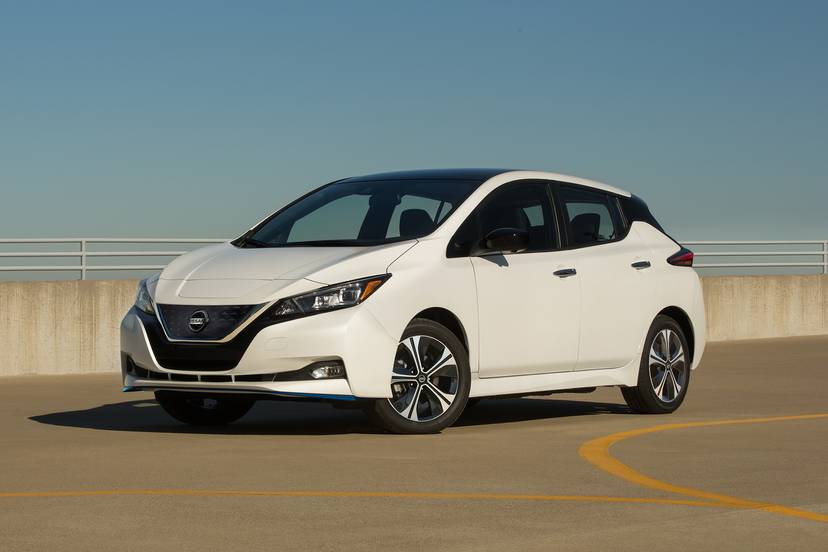
When it debuted as a 2011 model, the Nissan Leaf brought the possibility of all-electric driving to the masses — including us: Cars.com purchased a 2011 Leaf along with a 2011 Chevrolet Volt range-extended electric car for our inaugural long-term test fleet. We learned a lot in our time with the Leaf, which proved to be a reliable, easy-to-drive commuter car for the year and a half we owned it.
The redesigned 2018 new Leaf starts at $30,875 ($885 destination charge included). That’s $690 less than the outgoing Leaf, but its EPA-estimated driving range has increased from 107 to 151 miles on a full charge. For this test, we drove the top SL trim with a $38,260 as-tested price. Our test car had a $650 SL Technology Package, which includes Nissan’s ProPilot Assist driver-assist technology, as well as active safety features like automatic emergency braking with pedestrian detection. It’s also the only trim level to include a Level 2 charging station (excluding installation), which would cost several hundred dollars purchased separately. Leaf buyers remain eligible for a federal tax credit of up to $7,500, and many states and municipalities offer separate incentives tied to the purchase, driving, charging and parking of EVs.
Compare the 2018 Leaf with the rival Chevrolet Bolt EV and Hyundai Ioniq Electric here, and compare the 2018 Leaf with the 2017 Leaf here.
Designed to Blend In
One of the biggest changes for 2018 is how the Leaf looks. The original Leaf hatchback had a distinctive, bulbous shape that was different from most everything else on the road, communicating to your fellow drivers that this was not some ordinary gas-powered car. Now, the Leaf could be mistaken for one of Nissan’s conventional hatchbacks: Gone are the headlights that stretched up the front fenders, replaced with less daring horizontal lights, and the front end has adopted Nissan’s corporate V-Motion grille, seen on everything from the Murano SUV to the Sentra compact car.
A similar metamorphosis has happened at the rear. The previous Leaf’s slender taillights that stretched to the roof have been ditched in favor of boomerang-shaped ones. The rear pillars have been blacked out, too, giving the roof a floating appearance. (The Murano uses the same design.)
Drives Like a Regular Car
Even if you’re new to electric vehicles, the new Nissan Leaf’s driving experience should seem familiar — and, apart from a few unique characteristics, rather ordinary. This, however, is a very good thing, as we’ve been in more than a few alternatively powered cars with various driving quirks.
In its Normal drive mode, the Leaf accelerates smoothly and builds speed quickly enough. Other editors thought the Chevy Bolt EV felt quicker, but the Leaf doesn’t have trouble keeping pace with traffic. The Leaf’s braking response is smooth and predictable, and that’s a big deal; in some alternative-fuel cars, brake-pedal feel is half-baked, with the traditional friction brakes and regenerative braking system not well-synchronized. Nissan, however, has it figured out. Well done.
I was, however, disappointed in the second generation Leaf’s ride quality. The suspension tuning is firm, but beyond that there’s a harshness in its responses that’s out of place in a modern car. The ride can also feel choppy on certain surfaces, like concrete. That said, another editor thought it rode better than the Bolt EV.
Light-effort steering contributes to the Leaf’s nimble and lively feel on city streets, but the system doesn’t provide much feedback. The car is poised in corners, but it doesn’t ever feel sporty. The seats are part of the reason; though the front bucket seats are comfortable, their side bolsters aren’t substantial enough to hold you in place through fast corners. I slid all over the seat cushion.
All Leafs include an Eco mode that increases regenerative braking, limits motor output and reduces climate-control power. Eco can add a few miles to the instrument panel’s estimated driving range, but it takes away a lot of the zip; accelerator-pedal response is severely diminished, and acceleration is painfully slow.
More Range = Less Anxiety
The original 2011 Leaf’s 24-kilowatt-hour lithium-ion battery pack gave the car an EPA-estimated driving range of 73 miles. When driving our long-term 2011 Leaf, it was wise to keep a close eye on the range display — especially in winter months — when the heating system placed greater demands on the battery. The Leaf’s EPA-estimated driving range has steadily improved since then, with the biggest year-over-year increase coming with the 2018 Leaf and its higher-capacity 40-kilowatt-hour battery pack. The result is that you no longer have to watch the car’s range display vigilantly in daily driving.
With the higher-capacity battery comes longer charging times. On 220-volt electrical service, the battery takes as little as 7.5 hours for a full charge, Nissan says. On a 110-volt household outlet, it will take about 35 hours.
SV and SL trim levels include a CHAdeMO quick-charge port for much quicker public charging, but it’s not designed to bring the battery past an 80 percent charge. I quick-charged the 2018 Leaf during a lunch break, and my 30-minute charging session cost $11.15 and added 17.5 kwh to the battery pack (which brought it to 75 percent capacity); that was good for an additional 79 miles of driving range, as reported by the instrument panel’s range display.
Missed Opportunities
Given the Leaf’s significant styling and drivetrain updates for 2018, it’s surprising that some of the prior generation’s biggest shortcomings remain.
Tilt-and-telescoping steering wheels are commonplace in new cars, but the 2018 Leaf, like its predecessor, still has only tilt adjustment. The lack of a telescoping steering column makes it harder to find a comfortable driving position. Meanwhile, the position of the rear bench seat relative to the floor results in an uncomfortable knees-up seating position for adults, as was the case in the old Leaf.
Likewise, the huge ledge between the cargo floor and the folded backseat is even more disappointing now than it was in the first-generation Leaf. It significantly reduces the versatility of the Nissan Leaf’s hatchback shape by preventing large cargo from lying flat on an extended floor.
Driver-Assist Technology
The 2018 Leaf offers two features — e-Pedal and ProPilot Assist — designed to make driving less stressful and safer, respectively.
The standard e-Pedal system is controlled by a switch on the center console. When active, the Leaf begins slowing the moment you start lifting off the accelerator. To do this, it uses regenerative braking from the electric motor and the stopping power of the car’s conventional brakes. If you keep letting off the accelerator, the Leaf will come to a complete stop and hold itself until you press the pedal to go again.
It didn’t take long to adapt to this way of driving, and the system worked well overall in slow-moving stop-and-go traffic. However, the drivetrain loses some of its responsiveness when the system is on.
ProPilot Assist, meanwhile, is a driver-assist system that steers the Leaf to keep it in its lane and adjusts the car’s speed to maintain a desired following distance from traffic directly in front of you. The system steers smoothly but liked to hug the right side of the lane. Unlike GM’s Super Cruise system, you must keep a hand on the steering wheel when using ProPilot Assist; if the system thinks you’ve let go of the wheel, it will issue a series of alerts — first a visual warning, then an audible warning and finally a tap of the brakes — to get you to grab the wheel.
Should You Get One?
Even though Nissan missed a few opportunities to fix some of the Leaf’s shortcomings, the 2018 Leaf’s longer driving range makes it a viable choice for more eco-minded shoppers, where its predecessor wasn’t. If you’re looking to make the move from gas-car ownership to electric-car driving, a 2018 Nissan Leaf should make the switch relatively pain-free.
Cars.com’s Editorial department is your source for automotive news and reviews. In line with Cars.com’s long-standing ethics policy, editors and reviewers don’t accept gifts or free trips from automakers. The Editorial department is independent of Cars.com’s advertising, sales and sponsored content departments.














































